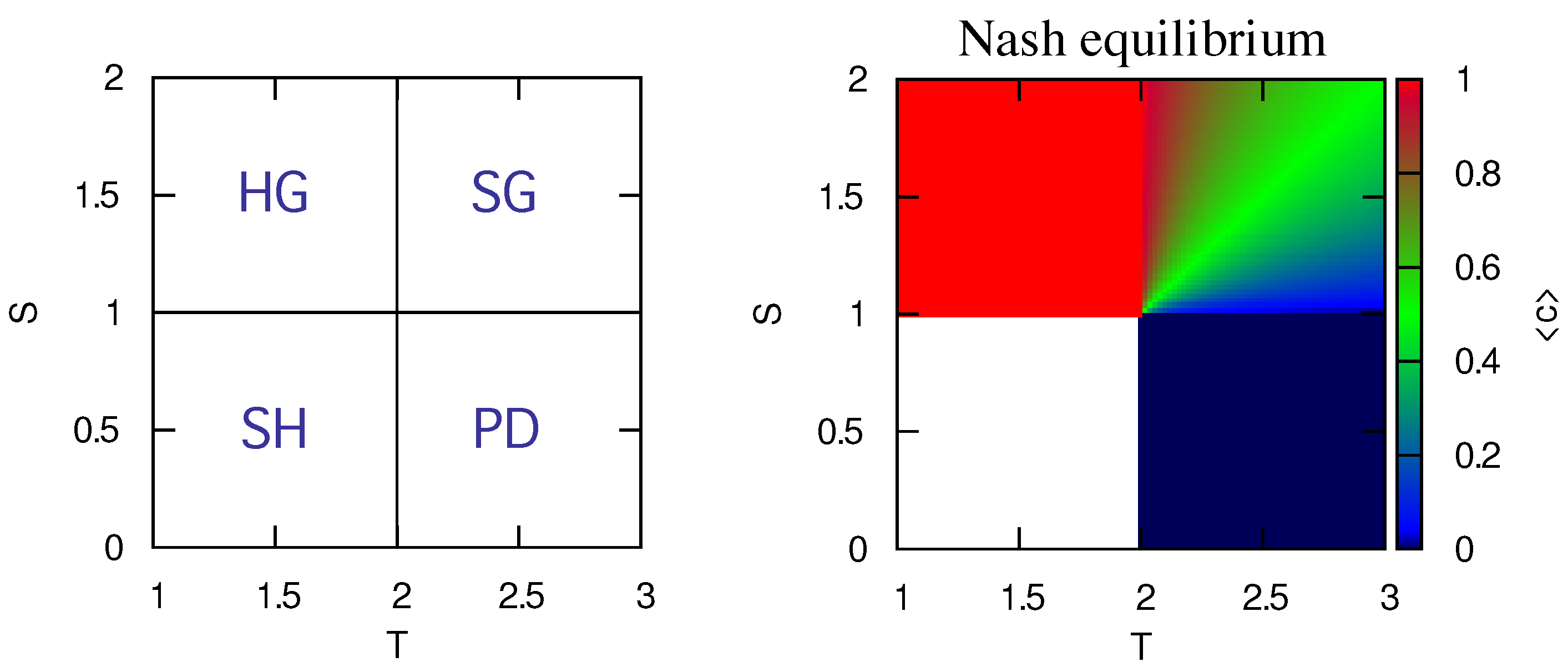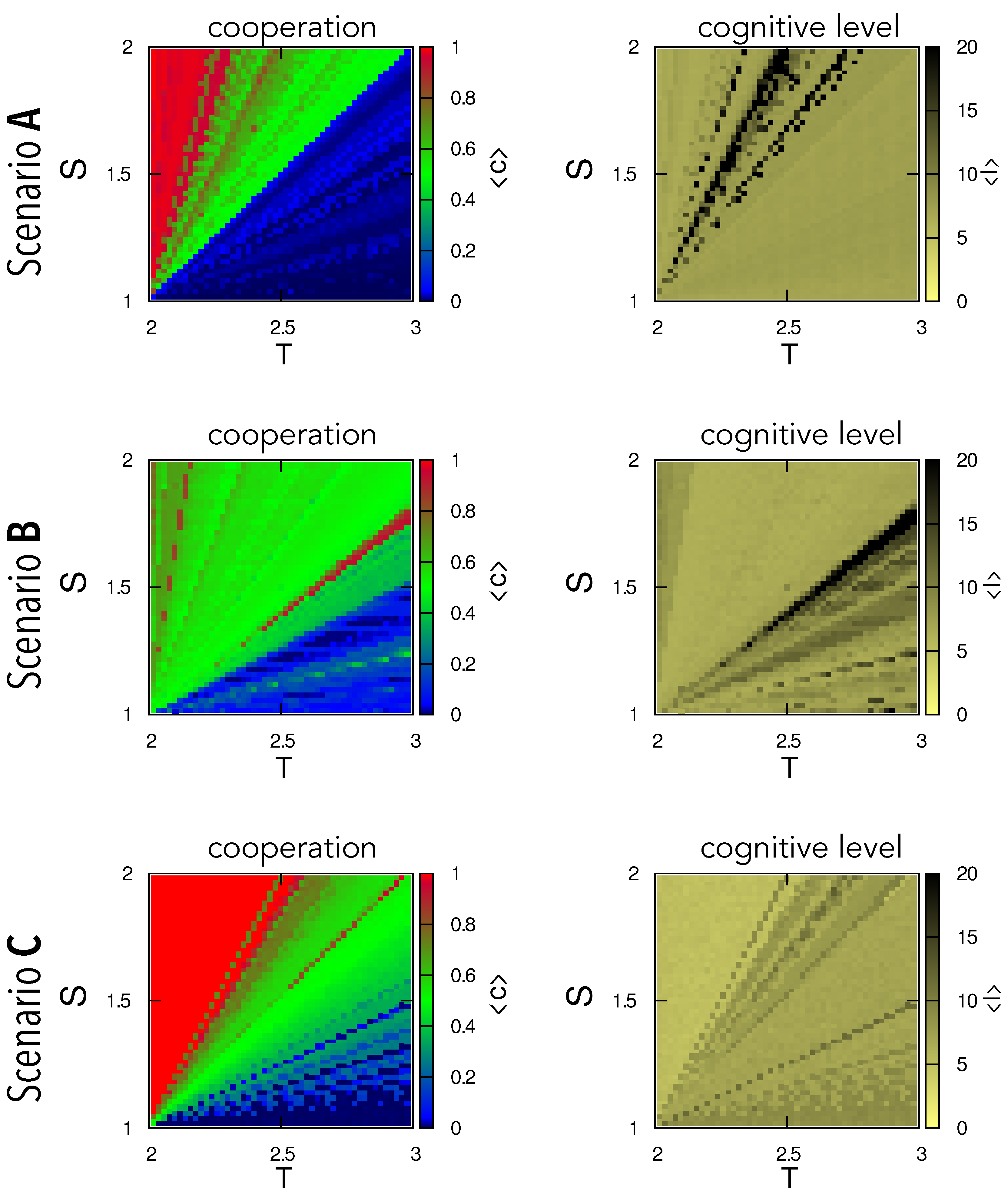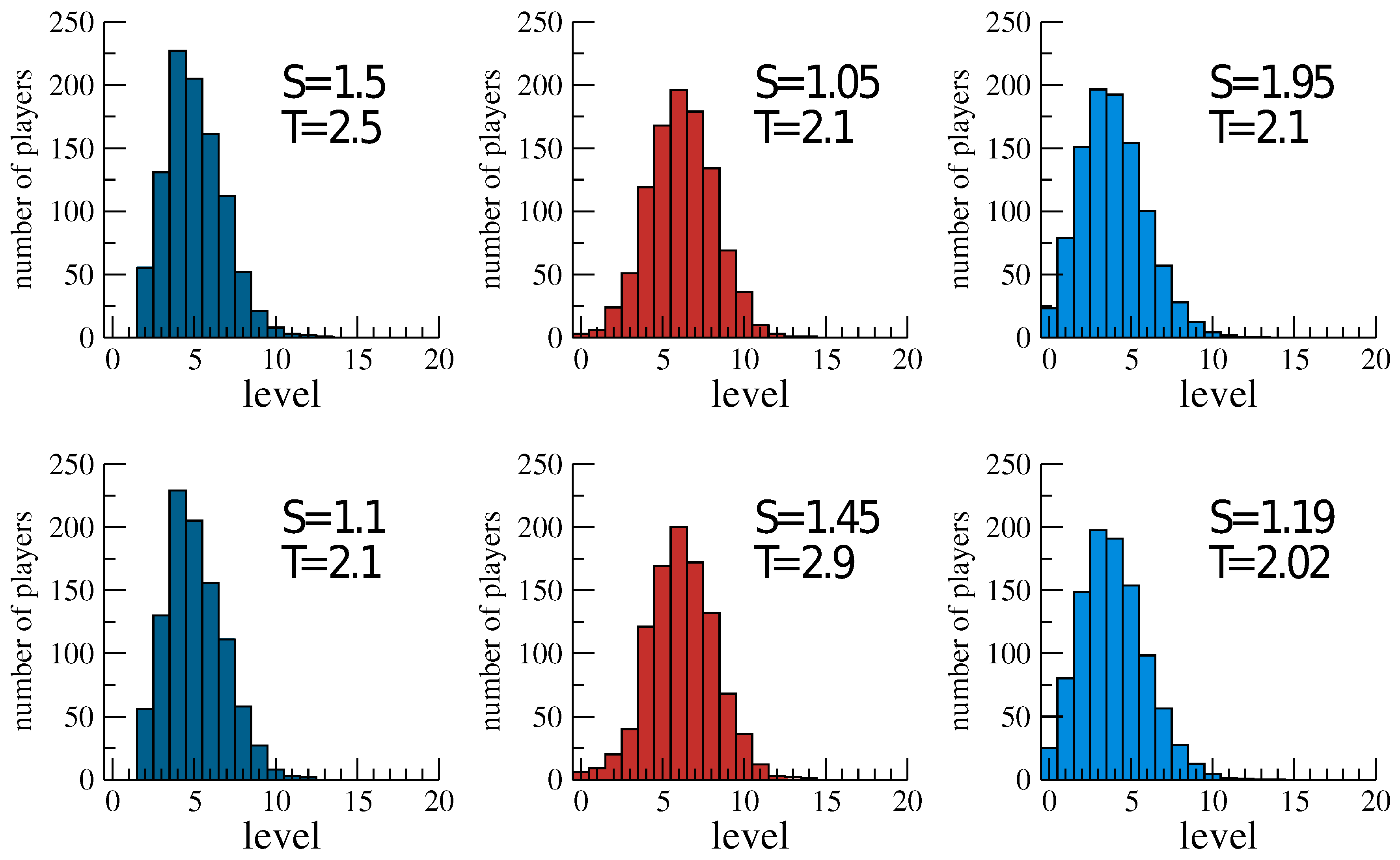Cognitive Hierarchy Theory and Two-Person Games
Abstract
:1. Introduction
2. Results
2.1. Preliminary Concepts
2.1.1. Two-Person Games
2.1.2. Cognitive Hierarchy Theory
2.2. Analysis
2.2.1. Harmony Game
2.2.2. Prisoner’s Dilemma
2.2.3. Stag Hunt
- (i)
- For , we have , and Level-1 players will cooperate. Thus, the average cooperation c assumed by a Level-2 player will be . Provided , i.e., Level-2 players assume at least one Level-1 player, we have , and therefore (using that, for , is a decreasing function of c), , which implies that a player of Level-2 playing an SH will choose to cooperate if .
- (ii)
- For , we have , and Level-1 players will defect. The assumed cooperation level c is . Provided , we have ; hence (as ) , and thus, a player of Level-2 playing an SH will chose to defect if .
2.2.4. Snowdrift Game
- (i)
- For , we have , and Level-1 players cooperate. Thus, the average cooperation c assumed by a Level-2 player will be . Provided , i.e., Level-2 players assume at least one Level-1 player, we have , and therefore, , which implies that a player of Level 2 playing an SG will choose to cooperate if , while she/he will choose to defect if , with .
- (ii)
- For , Level-1 players defect. Then, the assumed cooperation level c is . Provided , we have ; hence, (as ) . Thus, a player of Level 2 will choose to cooperate if , while she/he will choose to defect if , with .
- (a)
- , defection.
- (b)
- , cooperation.
- (c)
- , defection.
- (d)
- , cooperation.
2.2.5. Symmetries in the Snowdrift Game
2.3. Dynamics
2.3.1. Distributions of Cognitive Levels
2.3.2. Dynamics Algorithm
- Step 1
- The agents play simultaneously with the action that is the best response according to their current beliefs (random for Level-0 players), each one receiving a payoff .
- Step 2
- Each agent i compares her/his current and previous payoff. If , the agent i keeps her/his current belief on the population distribution, while if , the agent makes an attempt to change her/his belief.
- With probability u, agent i varies her/his level according to , that is, in an equiprobable way, she/he increases or decreases its level at a point.
- Otherwise (i.e., with probability ), she/he keeps her/his cognitive level.
- With probability u, agent i varies her/his level according to , that is, in an equiprobable way, she/he increases or decreases its level at a point.
- With probability v (where ), agent i varies her/his assumed rate parameter according to , where , preserving .
- Otherwise (i.e., with probability ), nothing changes.
2.3.3. Simulations Results
3. Conclusions
Acknowledgments
Author Contributions
Conflicts of Interest
Abbreviations
| HG | Harmony Game |
| PD | Prisoner’s Dilemma game |
| SG | Snowdrift Game |
| SH | Stag Hunt Game |
Appendix A
- Level-1 players cooperate if and only if .
- Level-2 players take the following actions, depending on the point representing the particular SG game:
- (a)
- , defection.
- (b)
- , cooperation.
- (c)
- , defection.
- (d)
- , cooperation.
| Scenario | Regions | Action |
|---|---|---|
| a.1 AND b.1 | D | |
| C | ||
| a.1 AND b.2 | D | |
| C | ||
| D | ||
| a.1 AND b.3 | D | |
| C | ||
| D | ||
| C | ||
| a.2 AND b.2 | D | |
| a.2 AND b.3 | D | |
| C |
Appendix B
- If , then ; thus, , and the payoff differences have the same sign; and the symmetry S2 is preserved.
- If , the symmetry is preserved, provided .
- If , then ; thus , and the payoff differences have the same sign; and the symmetry S2 is preserved.
- If , the symmetry is preserved, provided .
References
- Keynes, J.M. The State of Long-term Expectation. In The General Theory of Employment, Interest and Money; Harcourt Brace and Co.: New York, NY, USA, 1936. [Google Scholar]
- Moulin, H. Game Theory for the Social Sciences; NYU Press: New York, NY, USA, 1986. [Google Scholar]
- Farrell, J. Cheap talk, coordination, and entry. RAND J. Econ. 1987, 18, 34–39. [Google Scholar] [CrossRef]
- Darrough, M.N.; Stoughton, N.M. Financial disclosure policy in an entry game. J. Account. Econ. 1990, 12, 219–243. [Google Scholar] [CrossRef]
- Krugman, P. Peddling Prosperity: Economic Sense and Nonsense in the Age of Diminished Expectations; W. W. Norton and Co.: New York, NY, USA, 1995. [Google Scholar]
- Erev, I.; Rapoport, A. Coordination, “magic,” and reinforcement learning in a market entry game. Games Econ. Behav. 1998, 23, 146–175. [Google Scholar] [CrossRef]
- Rapoport, A.; Seale, D.A.; Winter, E. An experimental study of coordination and learning in iterated two-market entry games. Econ. Theory 2000, 16, 661–687. [Google Scholar]
- Stahl, D.O.; Wilson, P. On players’ models of other players: Theory and experimental evidence. Games Econ. Behav. 1995, 10, 218–254. [Google Scholar] [CrossRef]
- Costa-Gomes, M.; Crawford, V.P.; Broseta, B. Cognition and behavior in normal-form games: An experimental study. Econometrica 2001, 69, 1193–1235. [Google Scholar] [CrossRef]
- Camerer, C.F.; Ho, T.H.; Chong, J.K. A cognitive hierarchy model of games. Q. J. Econ. 2004, 119, 861–898. [Google Scholar] [CrossRef]
- Crawford, V.P.; Iriberri, N. Fatal attraction: Salience, naivete, and sophistication in experimental “hide-and-seek” games. Am. Econ. Rev. 2007, 97, 1731–1750. [Google Scholar] [CrossRef]
- Crawford, V.P.; Iriberri, N. Level-k Auctions: Can a Nonequilibrium Model of Strategic Thinking Explain the Winner’s Curse and Overbidding in Private-Value Auctions? Econometrica 2007, 75, 1721–1770. [Google Scholar] [CrossRef]
- Costa-Gomes, M.A.; Weizsäcker, G. Stated beliefs and play in normal-form games. Rev. Econ. Stud. 2011, 75, 729–762. [Google Scholar] [CrossRef]
- Hossain, T.; Morgan, J. When do markets tip? A cognitive hierarchy approach. Market. Sci. 2013, 32, 431–453. [Google Scholar] [CrossRef]
- Dawes, R.M. Social dilemmas. Annu. Rev. Psychol. 1980, 31, 169–193. [Google Scholar] [CrossRef]
- Kollock, P. Social dilemmas: The anatomy of cooperation. Annu. Rev. Soc. 1998, 24, 183–214. [Google Scholar] [CrossRef]
- Van Lange, P.A.M.; Joireman, J.; Parks, C.D.; van Dijk, E. The psychology of social dilemmas: A review. Organ. Behav. Hum. Dec. Process. 2013, 120, 125–141. [Google Scholar] [CrossRef]
- Smith, J.M. Evolution and the Theory of Games; Cambridge University Press: Cambridge, UK, 1982. [Google Scholar]
- Cooper, R. Coordination Games; Cambridge University Press: Cambridge, UK, 1998. [Google Scholar]
- Skyrms, B. The Stag Hunt and the Evolution of Social Structure; Cambridge University Press: Cambridge, UK, 2003. [Google Scholar]
- Sugden, R. The Economics of Rights, Cooperation and Welfare, 2nd ed.; Palgrave Macmillan: London, UK, 2005. [Google Scholar]
- Bramoullé, Y. Anti-coordination and social interactions. Games Econ. Behav. 2007, 58, 30–49. [Google Scholar] [CrossRef]
- Myerson, R.B. Game Theory-Analysis of Conflict; Harvard University Press: Cambridge, MA, USA, 1991. [Google Scholar]
- Gintis, H. Game Theory Evolving: A Problem-Centered Introduction to Evolutionary Game Theory, 2nd ed.; Princeton University Press: Princeton, NJ, USA, 2009. [Google Scholar]
- Sigmund, K. The Calculus of Selfishness; Princeton University Press: Princeton, NJ, USA, 2010. [Google Scholar]
- Perc, M.; Szolnoki, A. Social diversity and promotion of cooperation in the spatial prisoner’s dilemma game. Phys. Rev. E 2008, 77, 011904. [Google Scholar] [CrossRef] [PubMed]
- Kagel, J.H.; Roth, A.E. The Handbook of Experimental Economics; Princeton University Press: Princeton, NJ, USA, 1997. [Google Scholar]
- Camerer, C.F. Behavioral Game Theory: Experiments in Strategic Interaction; Princeton University Press: Princeton, NJ, USA, 2003. [Google Scholar]
- Rapoport, A.; Guyer, M. A taxonomy of 2 × 2 games. Gen. Syst. 1966, 11, 203–214. [Google Scholar]
- Axelrod, R.; Hamilton, W.D. The evolution of cooperation. Science 1981, 211, 1390–1396. [Google Scholar] [CrossRef] [PubMed]
- Poncela-Casasnovas, J.; Gutiérrez-Roig, M.; Gracia-Lázaro, C.; Vicens, J.; Gómez-Gardeñes, J.; Perelló, J.; Moreno, Y.; Duch, J.; Sánchez, A. Humans display a reduced set of consistent behavioral phenotypes in dyadic games. Sci. Adv. 2016, 2, e1600451. [Google Scholar] [CrossRef] [PubMed]
- Hofbauer, J.; Sigmund, K. Evolutionary Games and Population Dynamics; Cambridge University Press: Cambridge, UK, 1998. [Google Scholar]
- Gintis, H. Game, Theory Evolving; Princeton University Press: Princeton, NJ, USA, 2000. [Google Scholar]
- Hofbauer, J.; Sigmund, K. Evolutionary game dynamics. Bull. Am. Math. Soc. 2003, 40, 479–519. [Google Scholar] [CrossRef]






© 2017 by the authors; licensee MDPI, Basel, Switzerland. This article is an open access article distributed under the terms and conditions of the Creative Commons Attribution (CC-BY) license (http://creativecommons.org/licenses/by/4.0/).
Share and Cite
Gracia-Lázaro, C.; Floría, L.M.; Moreno, Y. Cognitive Hierarchy Theory and Two-Person Games. Games 2017, 8, 1. https://doi.org/10.3390/g8010001
Gracia-Lázaro C, Floría LM, Moreno Y. Cognitive Hierarchy Theory and Two-Person Games. Games. 2017; 8(1):1. https://doi.org/10.3390/g8010001
Chicago/Turabian StyleGracia-Lázaro, Carlos, Luis Mario Floría, and Yamir Moreno. 2017. "Cognitive Hierarchy Theory and Two-Person Games" Games 8, no. 1: 1. https://doi.org/10.3390/g8010001
APA StyleGracia-Lázaro, C., Floría, L. M., & Moreno, Y. (2017). Cognitive Hierarchy Theory and Two-Person Games. Games, 8(1), 1. https://doi.org/10.3390/g8010001







